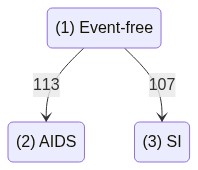AIDSI example
From Data Analysis with Competing Risks and Intermediate States, Book by Ronald B. Geskus:
The data contains information on two event types, “AIDS” and “SI”, which compete to be the first to occur.
Time is given in years since HIV infection. There are two different representations of the information on the event type that occurred first.
In the cause column, the event type is described in words, whereas in the status column a numeric respresentation is used.
The ccr5 column contains the information on the presence of the deletion CCR5-∆32. Individuals that don’t have the deletion have the value WW (W stands for “wild type”). Individuals that have the deletion on one of the chromosomes have the value WM (M stands for “mutation”)
See also: https://www.rdocumentation.org/packages/mstate/versions/0.3.1/topics/aidssi
